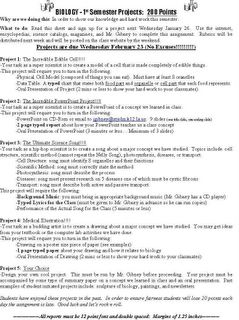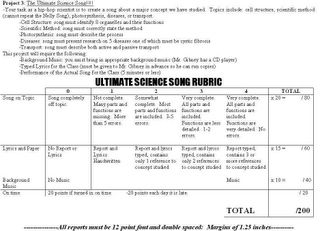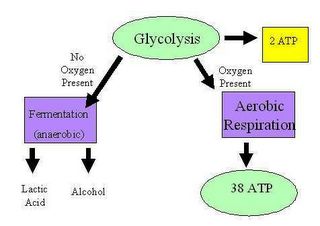ESJH Biology - Med 101
Mr. Gibney's Biology - Med 101 Class Fall 2006 -Check here for assignments, rubrics, extra credit, and life lessons
Sunday, January 30, 2005
Saturday, January 29, 2005
Biology Extra Credit Assignment
This online assignment is worth 30 Extra Credit Points. Click here and learn about performancing enhancing drugs. I promise it will be worth your time!!!
One of the top five slides of the year. If you can explain it you know some Bio!!! Notice how the sun feeds plants which then produce glucose and oxygen which plants and animals use for energy. The plants and animals produce carbon dioxide and water in a process called cellular respiration. Which the plants use with the sun to start the process all over again. What a wonderful web of life!!!


Thursday, January 27, 2005
No practice questions
Sorry.. no practice questions this week. Just review the clinical. I just got done with practice and must roll to the library for tutoring.
best,
J. Gibney
Saturday, January 22, 2005
Thursday, January 20, 2005
Sample Residency Questions for 1-21
Multiple Choice
Identify the letter of the choice that best completes the statement or answers the question.
____ 1. The smallest units of life in all living things are
a. cells. b. mitochondria. c. cytoplasm. d. Golgi apparatus.
____ 2. Surface area is an important factor in limiting cell growth because
a. the cell can burst if the membrane becomes too large. b. materials cannot enter the cell if it is too large. c. the cell may become too large to take in enough food and to remove enough wastes. d. waste products cannot leave the cell if it is too small.
____ 3. Which of the following is characteristic of prokaryotes?
a. They have a nucleus. b. They were found on Earth before eukaryotes. c. The organelles in their cytoplasm are surrounded by membranes. d. None of the above
____ 4. Which of the following is an example of a prokaryotic cell?
a. amoeba b. virus c. bacterium d. liver cell
____ 5. Studying a picture of a cell taken with an electron microscope, you find that the cell has no nucleus and no mitochondria, but it does have a cell membrane and a cell wall. You conclude that the cell is probably from a(n)
a. animal. b. plant. c. prokaryote. d. now extinct organism.
____ 6. The structure that regulates what enters and leaves the cell is called
a. the nucleus. b. the cell wall. c. the nuclear membrane. d. the cell membrane.
____ 7. Cell membranes
a. are only found on a small number of cells. b. contain genes. c. are made of DNA. d. are thin coverings that surround cells.
____ 8. The cell membrane
a. encloses the contents of a cell. b. allows material to enter and leave the cell. c. is selectively permeable. d. All of the above
____ 9. A structure within a cell that performs a specific function is called a(n)
a. organelle. b. organ tissue. c. tissue. d. biocenter.
____ 10. Golgi apparatus are organelles that
a. receive proteins and lipids from the endoplasmic reticulum. b. label the molecules made in the endoplasmic reticulum with tags that specify their destination. c. release molecules in vesicles. d. All of the above
____ 11. One important organelle that helps maintain homeostasis by moving supplies from one part of the cell to the other is the
a. endoplasmic reticulum. b. mitochondrion. c. Golgi apparatus. d. cytoplasm.
____ 12. In which of the following organelles is a cell’s ATP produced?
a. mitochondrion b. endoplasmic reticulum c. Golgi apparatus d. lysosome
____ 13. Proteins are made in cells on the
a. mitochondria. b. ribosomes. c. nucleus. d. cell membrane.
____ 14. The packaging and distribution center of the cell is the
a. nucleus. b. Golgi apparatus. c. central vacuole. d. nuclear envelope.
____ 15. The double membrane surrounding the nucleus is called the
a. nucleolus. b. nuclear wall. c. nucleoplasm. d. nuclear envelope.
____ 16. All the following are found in both plant and animal cells, except
a. a cell wall. b. a cell membrane. c. mitochondria. d. the endoplasmic reticulum.
____ 17. The organelles in plant cells that contain a green pigment are the
a. mitochondria. b. bilayer lipids. c. chloroplasts. d. Golgi apparatus.
____ 18. Plant cells have large membrane-bound spaces in which water, waste products, and nutrients are stored. These places are known as
a. mitochondria. b. chloroplasts. c. Golgi apparatus. d. vacuoles.
____ 19. Which of the following is the correct order of organization of structures in living things, from simplest to most complex?
a. organ systems, organs, tissues, cells b. tissues, cells, organs, organ systems c. cells, tissues, organ systems, organs d. cells, tissues, organs, organ systems
cells
Answer Section
MULTIPLE CHOICE
1. A
2. C
3. B
4. C
5. C
6. D
7. D
8. D
9. A
10. D
11. A
12. A
13. B
14. B
15. D
16. A
17. C
18. D
19. D
Wednesday, January 19, 2005
Biology Computer Lab Activity
3rd Period Biology
4th Period Biology
Cell's Alive
Messing around with a microscope
How Marijuana Works
"Cells let us walk, talk, think, make love and realize the bath water is cold." Lorraine Lee Cudmore
Interactive Cells (backup in case cells alive doesn’t work)
Tuesday, January 18, 2005
Sunday, January 16, 2005
Tuesday, January 11, 2005
Extra Credit Bigger for your Convenience
I received a good comment about making the Extra Credit bigger. I tried to re-upload the file as a bigger one. It should be bigger when you click on it.
Thanks for the info!!
best,
J. Gibney
Tuesday, January 04, 2005
Welcome to Biology
Welcome to Mr. Gibney's Biology Class Webpage. Below you will find the weekly extra credit problem. I will post study questions for Friday's Residency (test) here as well.
best wishes,
Mr. Gibney



















